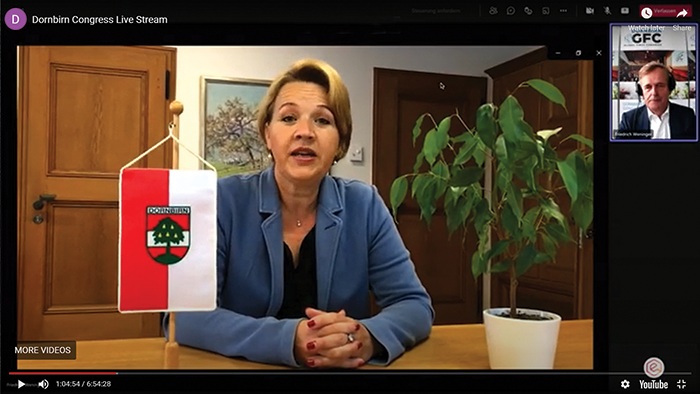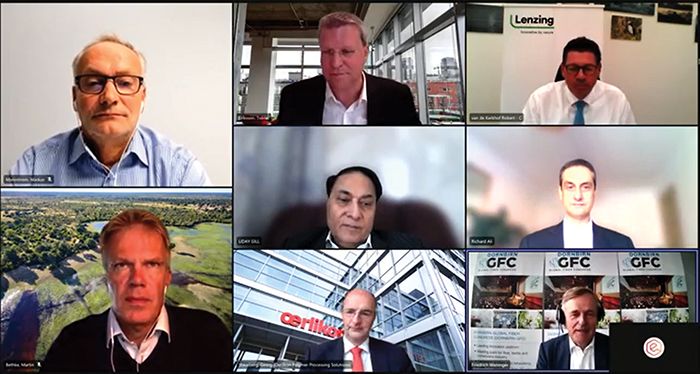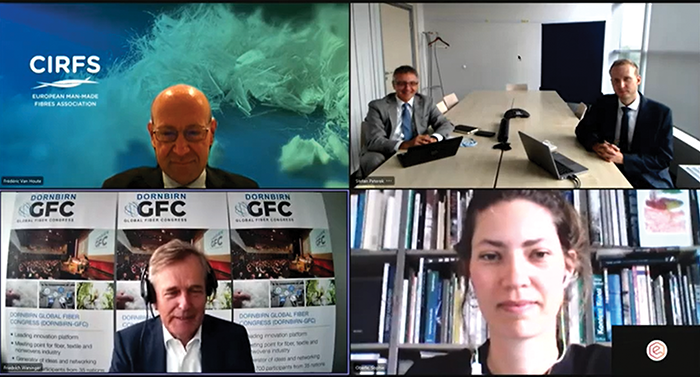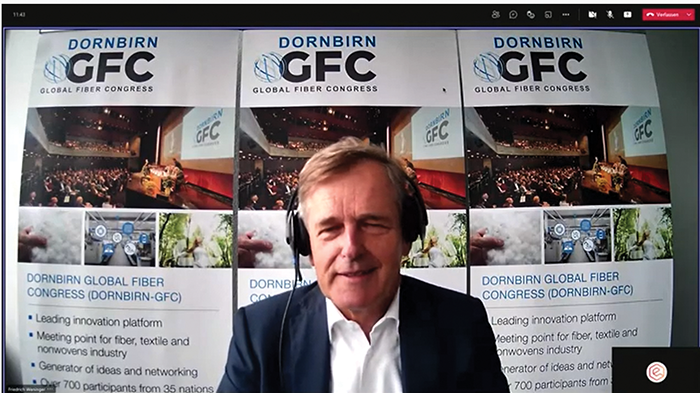For the second year running, the Dornbirn Global Fiber Congress (GFC), now in its 60th edition, was held as a virtual event. Besides the ongoing theme of sustainability, there was a strong emphasis on the circular economy and digitalization, as well as discussions on a wide range of topics from fiber innovation to fashion.
Synthetic fibers currently account for around 65% of global fiber production, and this trend is continuing to rise due to the increased global population and rising per capita consumption of textiles, particularly in the developing world. Natural fibers will continue to have a role, but these materials are generally unable provide all the performance features required in more technical applications.

Shift to polyester recycling
Georg Stausberg, chief executive officer, Oerlikon Polymer Processing Solutions Division, outlined the challenges posed by the fact that most polyester fibers end up in landfill.
“Most of the increased demand for synthetic fibers will be covered by polyester, which means we as an industry have a responsibility to deal with this and make the industry more sustainable,” he told the audience.
Textile consumption is growing significantly in Asia, and, interestingly, the consumption of manmade fibers is higher than in developed markets, where synthetic and natural fiber demand is more balanced, he said.
Stausberg noted that 38% of greenhouse gas emissions from the apparel and footwear chain are generated by material production. However, Oerlikon’s latest Wings technology can reduce energy consumption by up to 40% compared with previous machinery generations, thereby enabling customers to save more than 10 million tonnes of carbon dioxide (CO2) emissions in total during the 2007–2020 period.
With all the environmental challenges, such as land use and water consumption, as well as natural catastrophes, such as floods, heatwaves and drought, polyester fibers – fossil-based materials – are likely to be around for some time yet. However, there will be an increase in the production of recycled polyester, with Oerlikon predicting demand for 31 million tonnes by 2025.
“Our forecast is for the volume of recycled textiles to increase significantly,” said Stausberg. “The challenge for the fiber industry is to develop recycling technologies. Textile-to-fiber recycling will be much more localized, which could mean a further shift in the industry.”
He believed fossil-based polymers will still be around in 10 years’ time, but there will need to be solutions for recycling these materials. And for certain applications, biopolymers will become more important, such as for diapers and single-use wipes.
“There will need to be changes in the way we design textiles and to make them recyclable,” he said. “For us as a machine producer, the challenge will be to find the right balance in terms of what is recyclable and what will be biopolymer, and how new textiles will affect the design of our machines. As the only supplier of the entire fiber production supply chain, from melt to yarn, we can help our customers with recycling technologies.”
Stausberg noted that bottle-to-bottle and bottle-to-textile recycling are already well established, although these are almost exclusively based on mechanical recycling technologies. “The challenge is textile-to-textile recycling using chemical technologies,” he said. “The next step is deciding what to do with post-consumer waste, especially blends, such as polyester/cotton.”
Virtual presentations
With 96 scientific presentations and panel discussions across two virtual lecture halls, the fibers conference has moved on in many ways since it was first held in Dornbirn, Austria, in 1962, when just 13 lectures were presented to 130 delegates from 23 countries, although there was an extensive social program.
The last physical Dornbirn GFC in 2019 attracted around 700 participants from 34 countries. A first hybrid congress was held in South Korea in 2020 with 32 lectures and 200 participants, followed by a “virtual light Dornbirn” in 2020 with around 30 lectures. This year’s virtual event attracted around 400 delegates and 25 online exhibitors.

End of life
Opening the congress, Robert van de Kerkhof, chief operating officer of cellulosic fibers producer Lenzing, gave a somewhat depressing speech about product end of life amid all the negative messages surrounding CO2 emissions, water waste, microplastics and the decline of natural species.
“The additional consequence of this is ‘eco-anxiety’,” he said. “Every day we are confronted with bad news about the environment, which is having an impact on our social lives and individual moods.”
Van de Kerkhof, who is also president of the Austrian Fibers Institute, which organizes the congress, and currently president of CIRFS, the European manmade fiber association, said many people are feeling overwhelmed by the existing challenge of climate change. “However, it is up to us as individuals to turn this fear into something positive.
“For 60 years Dornbirn has been talking about innovations – and fibers are part of the solution. For example, they are essential in the construction of wind turbines, because we need move out of energy from coal as much as possible.”
Other fiber-based innovations can also have an impact, such as Lenzing’s Refibra technology, which is contributing to the circular economy by reusing cotton waste that is converted back to cellulosic pulp, thereby enabling 30% less virgin wood in the production of high-performance and functional fibers.
Global investment strategies
Van de Kerkhof also sees a drastic change in global investment strategies, away from coal-based technologies. “Fibers are fundamental for a more sustainable future across all industries, but we need to work together to drive systemic change,” he said. “The problems are so big and so complex that strategic partnerships are really critical.”
He said the fiber industry needs to be wary about repeating too many negative issues about the environment, while at the same time releasing its positive energy to help individuals to make an impact.
As part of this effort, Lenzing is sponsoring the 2022 Young Scientist Award at the Dornbirn GFC. Consisting of three categories – fashion and circularity; textile recycling; and most innovative use of bio-based fibers – the award offers a prize of €5,000 each, together with travel costs and the conference fee.
New business models
Uday Gill, chief strategy officer of Indorama Ventures, a Thailand-based chemicals group with investments in polyethylene terephthalate and fibers for diverse end-use markets, offered insights on how to compete beyond products and services in an era of unprecedented change.
“The consequences of human action remain hard to foresee,” he said. “At current resource-use models, however, only five billion people can sustainably live on our earth – a number that we passed decades ago.
“All the compelling issues facing the planet need radical action and business leaders need to embrace smart solutions that revolve around sustainability and technology as a source of competitive advantage and define new business models.
“Meanwhile, the circular economy is emerging as another competitive advantage. Business models are being designed for ‘new life’ instead of ‘end of life’ to protect the next generation.”
Consumers seeking experience
Today’s consumers are looking for customer “experience” over “stuff,” and negative experiences are more easily shared, Gill pointed out. Organizations also need more diversity in terms of, for example, gender, age, ethnicity, education and skills, which can lead to competitive advantage. Businesses can also capture the cognitive surplus to unlock the power of human creativity and create solutions to utilize free time.
Gill believes the shared economy can improve resource efficiency using logistics and technology, which are defining new business models, while the gig economy offers flexibility to companies and clients, which is creating new business models for working.
At the same time, digitally enabled businesses that embrace, for example, artificial intelligence (AI), robotics and machine learning, will enhance competitive advantage. However, the workforce displaced by automation will need reskilling and redeployment. “And COVID has shown us that the supply chain shocks will give an impetus to near-shoring,” he said.
Out of time?
Other keynote presentations included Martin Bethke, managing director, WWF Germany; Markus Mannström, board member and executive vice president Biomaterials Division, Stora Enso; and Richard Ali, vice president, communications, sustainability group, Huhtamaki.
In the CEO panel, moderated by Tobias Erikson, managing director of EFESO Consulting and involving all the earlier speakers, discussion revolved around cross-industry collaboration for sustainability. The panel agreed that partnerships, continuous improvement and investing in innovation are fundamental to improve efficiency and effectiveness, with an eye on the external targets that are set.
But does the fiber industry have time to make the required changes? Bethke admitted that the consumption of fashion materials is one of the world’s biggest problems, but said he had no answer for tackling this complex issue. “Time is of the essence. The ambition to tackle this cannot be high enough,” he said.
Reducing consumption not an option
Gill stated that any solutions will have to be profitable. Simply reducing consumption is not an option as any contraction of the economy would result in hardship and more poverty, he said. “However, we do need to conserve raw materials, reduce our carbon footprint and energy usage, use more clean energy, and introduce such things as automation and digitalization.”
He added that as the fiber and textile industry is far away from the end user, the good stories from producers are not getting to the consumer, “so we do not get the premium for our products. We need to use more technology to reach the consumer. Technology such as AI will solve research and innovation and industrial problems quickly. Meanwhile, circularity must be localized and infrastructure for reprocessing must be built locally – and it must be incentivized.
“When I come to Dornbirn I see so many innovative presentations from young people, but many of these will just remain as pilot projects or in the universities. What are we as an industry doing to bring this innovation to the consumer?”
Packaging discussions
For the first time in its history, Dornbirn GFC held a cross-sector discussion between the packaging and fiber industries to meet the challenges of a future sustainable environment.
In many cases, both industries share the same or similar feedstocks, production technologies and applications and will face the same challenges when it comes to sustainability and circular economy.
A “Deep Dive Session”, held in cooperation with EDANA, offered four lectures on opportunities for reuse and recycling of fibers from nonwovens, which were discussed at a roundtable chaired by EDANA general manager Pierre Wiertz.
Paul Schlack/Wilhelm Albrecht prize
The Paul Schlack/Wilhelm Albrecht Prize for 2021, which is awarded each year to promote manmade fiber research at universities and research institutes for outstanding work and research projects, was presented by CIRFS director general Frédéric van Houte to Dr. Stefan Peterek of RWTH Aachen for his work on cost-efficient wet spinning of polyacrylonitrile fibers with alternative solvents.

The honorary prize was awarded to Sophie Oberle of the Technical University Dresden for her master’s thesis on the development of yarns with material-intrinsic shape-changing properties from melt-spun polyvinylidene fluoride at industrial scale.
Interactive exchange
A new feature of congress was the virtual networking, although this appeared little used – a bit like speed-dating in an empty barn. And while this digital alternative to Dornbirn was, of course, not as good as seeing people face to face, at least the global fiber industry has been able to stay in touch.
“We hope to be live again next year in Dornbirn,” said congress director Friedrich Weninger.
The 61st Dornbirn GFC is scheduled to take place from September 14–16, 2022 in Dornbirn, Austria.
For more information contact:
Austrian Fibers Institute
Tel: +43 1 319 290941
Email: office@dornbirn-gfc.com
dornbirn-gfc.com


